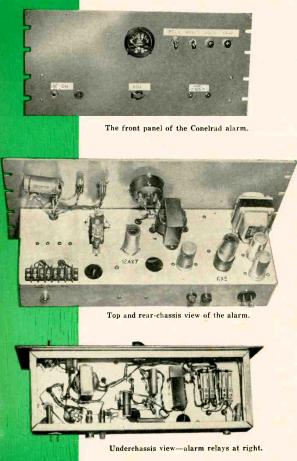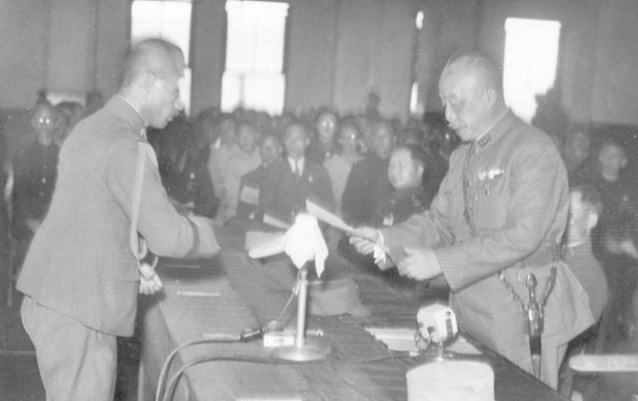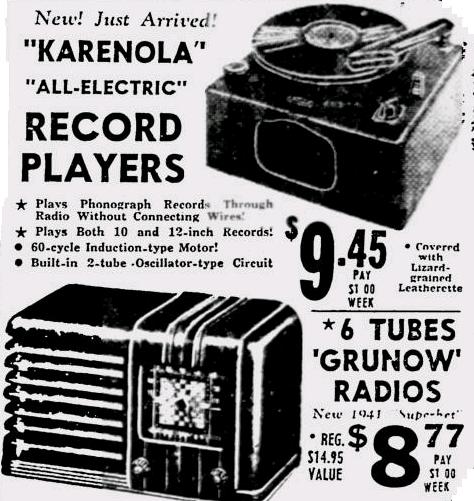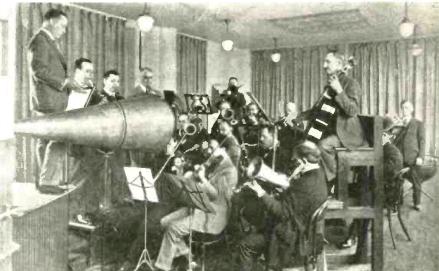Happy Halloween from OneTubeRadio.com!
The illustration here is from Halloween a century ago, from the 1915 book Story Plays Old And New, Volume 3.
Click Here For Today’s Ripley’s Believe It Or Not Cartoon
![]()

Happy Halloween from OneTubeRadio.com!
The illustration here is from Halloween a century ago, from the 1915 book Story Plays Old And New, Volume 3.
Click Here For Today’s Ripley’s Believe It Or Not Cartoon
![]()
There was a time when people still dressed up to listen to shortwave radio, as demonstrated by this elegant DX’er, undoubtedly tuning in a shortwave broadcast on her Grundig Majestic Pianissimo console. The elegant cabinet, with its natural walnut finish, contained five loudspeakers, an AM-FM-SW receiver, and an automatic phonograph.
This ad appeared in Life Magazine, October 29, 1956. The ad also featured three more consoles tuning the shortwave bands, as well as two table radios. Prices ranged from $69.96 up to $1495, at better stores everywhere.
Click Here For Today’s Ripley’s Believe It Or Not Cartoon
![]()
In 1950, Richard J. Buchan of Bricelyn, Minnesota, was apparently an avid basketball fan, and enjoyed following the Minneapolis Lakers. And he was apparently tantalyzed by the fact that the Lakers were carried on Channel 4 in the Twin Cities (then WTCN-TV), 105 miles to the north. WTCN also carried the state basketball tournament, and Buchan set out on a quest to pull those signals into his living room.
His quest had actually begun when KSTP came on the air on Channel 5 from St. Paul. Buchan was a ham (W0TJF), and “after studying antenna books and experimental charts put out by the FCC,” he came to the conclusion that KSTP would be putting out, at most, a 2.5 microvolt signal as far away as Bricelyn. He also knew that a 250 microvolt signal would be required for solid reception, a whopping 40 dB of gain. He set out on a yearlong quest to get those 40 dB of gain, and a “small set was purchased and connected up.” He initially began working on Yagi antennas and preamplifiers, and described his experimental quest in detail in an article in the October 1950 issue of Radio News.
Since he lacked any test equipment, he rigged a VTVM up to his television to serve as an S-meter, and set about experimenting. The Yagis and preamplifiers he tested were never enough to give him the elusive 40 dB of gain. In particular, to get sufficient gain from the Yagis, he found that the bandwidth was too narrow. If he maximized the gain for the audio, the video suffered, and vice versa. The problems were compounded by the entrance of Channel 4 to the airwaves with the elusive basketball games. He was soon resigned to the need for four Yagis, tuned for sound and picture on the two channels.
Much to his dismay, WOI-TV in Ames, Iowa, came on the air on Channel 4. Unfortunately, Ames was almost exactly 180 degrees away from Minneapolis, meaning that he now also had to worry about the front-to-back ratio of the Yagi. And by designing it for better front-to-back ratio, he lost gain. (Buchan reported that he made no attempt to tune in WOI, since it didn’t broadcast the elusive basketball games. As far as he was concerned, the Iowa station apparently represented nothing other than interference.)
After some more study, he finally decided to abandon the Yagis and instead go with a Rhombic, which would have a theoretically infinite front-to-back ratio, but still have sufficient gain to pull in the elusive basketball games. Fortunately for Buchan, he had a large field across the road where he could install the antenna, which measured 155 feet in length, pointed toward the Twin Cities. Even though the final rhombic was actually lower than the Yagis, it performed well. Other than “an occasional gurgle in the sound,” the QRM from WOI was eliminated.
Presumably, the antenna continued to function well until the Lakers left Minneapolis in 1959.
Buchan, whose amateur call sign expired in 1998, also published more detailed construction details in Rhombic TV Antennas in 1951.
Click Here For Today’s Ripley’s Believe It Or Not Cartoon
![]()
One hundred years ago today, twenty-one girls between the ages of 7 and 17 were killed in a fire at St. John’s School in Peabody, Massachusetts. Under the school’s established fire procedure, most students were to leave the building through a rear exit. But because the route was blocked by thick smoke, most instead tried to exit through the front door, where they became blocked in the vestibule. A major contributing factor was the fact that the front doors opened inward. The crowded vestibule was soon engulfed in flames, and the entire building was soon fully engulfed.
Most students were able to escape through first-floor windows, or even by jumping from higher windows. The school’s teachers, nuns of the Sisters of Notre Dame, acted heroically, by dropping many of the students to improvised life nets made of coats and blankets.
One lesson learned from this fire was that the exit doors of public buildings need to open out to avoid bottlenecks in case of fire. In the wake of the fire, Peabody became the first city to impose this requirement.
Every school with which I have been involved takes fire safety very seriously, and it is natural to ask the question of how successful these efforts have been. In other words, how often do we see a headline like the one at the top of this page?
The answer is that school fire safety has been extraordinarily successful. In the past half century, zero American schoolchildren have been killed by fires. There have, of course, been fires. But in over fifty years, there has not been a single fire fatality. Not a single one. And when we stop to think of why this is true, we can learn some lessons that will help prevent other tragedies.
The important thing to remember is that we cannot point to a single magic bullet that has prevented school fires. There is no one thing that we did to prevent them. We did a lot of things. And when we did them, we didn’t waste time worrying that we shouldn’t do them because that one thing wouldn’t prevent all fire fatalities. Nobody would call us paranoid for taking all of those precautions against something that hasn’t happened in 50 years. And nobody would argue that we shouldn’t take fire precautions because they might scare the children.
In the St. John’s fire, the critical lesson learned was that doors to public buildings should open out. But no sane person would stop there and conclude that by changing the doors on the school that we could prevent fire deaths. We fixed one safety hazard, but continued identifying other hazards. Here are some of the other things we have done for school fire safety over the years:
There are probably others that I’ve forgotten. But you get the idea. We haven’t had any fire fatalities because we have multiple redundant layers of protection. And nobody says that doing all of these things makes us paranoid. We’ve had zero fatalities because we do them.
During the same half century of extraordinary success in school fire safety, there have been more than 300 deaths from school shootings. Security expert Lt. Col. Dave Grossman makes the compelling case that we have to stop being in denial about school violence. Invariably, in the wake of a school shooting, the inclination is to come up with a single solution that will prevent the next one. But we need to take the same approach that we do to fire safety: What we really need are multiple redundant layers of protection. Some of the possibilities suggested by Grossman include:
Will any one of these steps prevent every possible school shooting scenario? No. Having a police officer in the school is not the one magic bullet that will prevent every school shooting. Having the responding officer equipped with a rifle in his or her trunk is not the one magic bullet that will prevent every school shooting. And having a handful of random citizens armed is not the one magic bullet that will prevent every school shooting.
But having sprinklers is not the one magic bullet that will prevent every fire death. Having fire drills is not the one magic bullet that will prevent every fire death. Having doors that open out is not the one magic bullet that will prevent every fire death. But we did all of those things anyway, because if we do all or most of these things, then it is very likely that these multiple redundant precautions together will prevent most fire deaths. The last half century of American history proves that this is true.
A hundred years ago, when 21 girls were killed in a school fire, we learned one lesson, but we also kept on learning our lessons. Lessons were learned from the fire at Our Lady of the Angels School in Chicago on December 1, 1958 when 95 were killed. The net result is that we have learned these lessons, and we continue to have multiple redundant layers of security to prevent them. And because those measures have proven so successful, we keep at it. Nobody says that we’re paranoid. Nobody tells us to stop because we’ll scare the children. We simply do what we need to do because it works.
According to findagrave.com, these are the names of the girls killed in the fire a hundred years ago today:
At that same site, you can view the statue erected in 2005 in memory of the girls who were killed. It depicts two of them in the embrace of their Saviour.
Click Here For Today’s Ripley’s Believe It Or Not Cartoon
![]()
 From 1951-1963, U.S. broadcast stations were required to participate in CONELRAD, a system designed to alert the public to enemy attack, but also deprive enemy bombers of radio signals which could be used for navigation purposes. Under a CONELRAD alert, all stations would cease broadcasting on their normal frequencies. Designated stations would switch to broadcasting on either 640 or 1240 kHz. The result would be that listeners would be able to hear alerts, but enemy bombers would hear only a confusing jumble of signals on those frequencies.
From 1951-1963, U.S. broadcast stations were required to participate in CONELRAD, a system designed to alert the public to enemy attack, but also deprive enemy bombers of radio signals which could be used for navigation purposes. Under a CONELRAD alert, all stations would cease broadcasting on their normal frequencies. Designated stations would switch to broadcasting on either 640 or 1240 kHz. The result would be that listeners would be able to hear alerts, but enemy bombers would hear only a confusing jumble of signals on those frequencies.
For the system to work, each station needed an alarm. For smaller stations, this would consist of an alarm tuned to another station in the area. If the primary station went off the air, then the smaller station would be alerted. If it turned out to be an actual alert, they would need to leave the air or switch to their designated frequency. Alarms were available commercially for broadcast stations, and simpler models were also available for hams, who were later required to participate in CONELRAD. Many hams built their own, and there were many plans published over the years. Sixty years ago this month, the October 1955 issue of Radio Electronics magazine carried the plans for the unit shown here, which was in use at WRFD, a Worthington, Ohio, 5000 watt daytime only station affiliated with Fram Bureau Insurance, with a format aimed at the agricultural market.
The author of the construction article was Harold Schaaf, the station’s chief engineer, who noted a critical defect in many of the existing CONELRAD alarms. Most of them depended on a normally open relay which would close in case of an alert. If the alarm circuit failed for some reason, there would be no relay action.
Schaaf noted that “such a system cannot be considered reliable, since it can go out of order without the operator knowing it.” Schaaf’s circuit instead included a relay that remained energized during normal operation. In the case of a circuit fault such as a failure of one of the tubes, the relay would de-energize, which would cause the alarm to sound, requiring the station operator to investigate. The result was what the title of the article described as a “failure-proof CONELRAD alarm.”
Like most other CONELRAD alarms, this one was hooked to the AVC circuit of a superheterodyne receiver tuned to the station being monitored. As long as there was an AVC voltage present, the alarm would remain silent. If the monitored station went off the air, the AVC voltage would disappear, which would trigger the alarm, which could consist of an external bell.
Click Here For Today’s Ripley’s Believe It Or Not Cartoon
![]()
The plans for this five-tube superhet, dubbed the “High Fidelity Five,” appeared in Popular Mechanics 75 years ago this month, October 1940. It got this name due to its tone control circuit, which enabled the “small set to have a bass response comparable to that of a large receiver,” since the circuit could amplify the lower tones without distortion. The set also featured mechanical pushbutton tuning, with a tuning assembly that was commercially available. The project was not designed for beginners, but was “quite simple and well within the building range of the average experimenter.” Cabinet details were given, but the article mentioned that suitable cabinets were available for purchase.
The set had a transformer for both the B+ and filament voltages, and employed a electro-dynamic speaker, with the field coil also serving to filter the output of the power supply. While the full schematic and pictorial diagrams were given in the article, blueprints were also available for purchase.
Click Here For Today’s Ripley’s Believe It Or Not Cartoon
![]()

Chen Yi (right) accepting surrender of General Rikichi Andō (left), last Japanese Governor-General of Taiwan, Taipei City Hall, October 25, 1945. Wikipedia photo.
Today marks the 70th anniversary of Taiwan’s Retrocession Day, October 25, 1945. It marked the end of a half century of colonial rule by the Japanese. The anniversary remains a public holiday in Taiwan.
 If you were looking for a low-cost radio or phonograph 75 years ago today in Milwaukee, then Economy Boys would be the store to visit. In the store’s ad in the October 24, 1940, issue of the Milwaukee Journal,
If you were looking for a low-cost radio or phonograph 75 years ago today in Milwaukee, then Economy Boys would be the store to visit. In the store’s ad in the October 24, 1940, issue of the Milwaukee Journal,
we see this six-tube Grunow superhet broadcast receiver for just $8.77.
The phonograph, selling for just $9.45, is actually a “phono oscillator.” Instead of including an audio amplifier and speaker, this Karenola model contains a two-tube oscillator circuit, which broadcasts the radio sound to a nearby broadcast radio. Even if the radio is a low-price model without a phono jack, you simply tune to a blank spot on the dial to listen to your records.
At Economy Boys, you could take home either set for just a dollar a week.
Unfortunately, I wasn’t able to pin down the model number of either. Most Grunow radios I’ve seen had wood cabinets, and this one appears to be plastic or bakelite. The Karenola name is probably more familiar as Trav-Ler, since the phonograph was from the Trav-Ler Karenola company of Chicago.
It’s generally accepted in the history of science and technology that radio couldn’t have been invented until James Clerk Maxwell came up with Maxwell’s Equations in 1865. That theoretically underpinning of radio were verified experimentally by Heinrich Hertz in 1887. (Hertz, it turned out, was using electromagnetic waves of about two meters in wavelength, it turns, meaning that the first intentionally generated radio waves were probably in or near the two meter amateur band.)
The prevailing wisdom, which is more or less true, is that someone like Guglielmo Marconi in the 1890’s couldn’t have come along and turned radio into a practical device without the prior work of Maxwell and Hertz.
While that statement is generally true, it ignores Dr. Mahlon Loomis, a dentist and inventor who was born in 1826 and died in 1886, the year before Hertz’s experiments. And it appears that in 1866, he successfully communicated wirelessly between two mountains fourteen miles apart. Unfortunately, he produced no independent witnesses to verify the claim. And his understanding was that some layer of the sky was completing a direct-current circuit, using the atmosphere as a conductor to send the direct current.
Even though his explanation is impossible, it’s likely that he was sending and receiving radio signals. FIrst of all, his sending mechanism appears to have included a spark gap between the aerial and ground. And more critically, Loomis found that the system would work only if the two aerials were extended to the same length. He surmised that they were both coming into contact with the same level of the atmosphere, through which the DC current was conducted. But the more likely explanation is that the two antennas were both resonant to the same frequency of radio wave.
In 1872, he was issued U.S. Patent 129971 for his wireless telegraph. And in 1873, the U.S. Congress even chartered the Loomis Wireless Telegraph Company. Loomis was, however, never able to raise sufficient capital to make the venture a practical reality.
It’s probably true that radio pioneers such as Marconi couldn’t have succeeded without Maxwell and Hertz telling them that it was theoretically possible to send electromagnetic waves through space. But it’s not a foregone conclusion. Loomis shows that history could have played out the other way around: Someone could have accidentally discovered radio (as it appears that Loomis did), and only then the physicists could be called upon to explain how it works.
Fifty years ago this month, there was an interesting article about Loomis in Popular Electronics, October 1965, written by Thomas Appleby, W3AX. The illustration above is taken from that article. Appleby was also the author of Mahlon Loomis, Inventor of Radio, published in 1967.
lick Here For Today’s Ripley’s Believe It Or Not Cartoon
![]()
 Tenor Enrico Caruso died in 1921, but the January 1938 issue of All Wave Radio magazine noted that the program “The Music You Want to Hear When You Want It,” sponsored by RCA-Victor occasionally carried a “recreated Caruso record” with the voice of Caruso and a recreated orchestral accompaniment. Recording technology had advanced a great deal in the intervening years, as shown by the accompanying photograph of an early recording session, probably taken in the late 1910’s.
Tenor Enrico Caruso died in 1921, but the January 1938 issue of All Wave Radio magazine noted that the program “The Music You Want to Hear When You Want It,” sponsored by RCA-Victor occasionally carried a “recreated Caruso record” with the voice of Caruso and a recreated orchestral accompaniment. Recording technology had advanced a great deal in the intervening years, as shown by the accompanying photograph of an early recording session, probably taken in the late 1910’s.
In Caruso’s day, it was necessary to record the entire performance thought a single horn. The article explains how the violins were placed near the horn for maximum pickup. The frequency range possible meant that the drums wouldn’t be picked up well anyway, so they were situated near the rear.
The soloist’s voice would, however, be picked up well, and the frequency range of the early recordings faithfully preserved Caruso’s voice. Therefore, it was possible to do a recreation broadcast. Using more modern electronic methods, the orchestra could be picked up well. A new live orchestra accompanied a perfect copy of the old recording for broadcast. The conductor wore headphones, listening to the recording as he conducted to keep perfect time.
The result was a new “live” broadcast of Caruso.